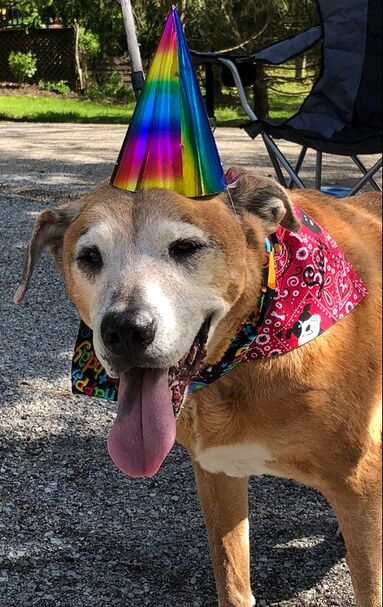 Twelve dogs. Thirty-two people. Utter chaos. But what would you expect at a “Sweet 16” party for the neighborhood’s aged, treat-demanding road warrior, known to all for her staggering determination as she winds her way from one friend’s house to the next, stubbornly dragging her recalcitrant back legs…and her impatient, frequently annoyed human? Yes, indeedy, last weekend Lucy was queen for a day. Somehow she seemed to know that all her friends had gathered in our cul-de-sac to honor her amazing longevity. At a muscle-bound 70 pounds, few would have predicted a dog her size would live so long. Was it the daily walks that started as soon as she arrived at our home at nine months? The vet-recommended dog food? The crazy mix of breeds her recent DNA test revealed (American Bulldog, Doberman Pinscher, Llewellin Setter, German Shepherd, Norwegian Elkhound, Chow, Boxer, and Lhasa Apso)? Or, more likely, was it her newfound joy in socializing that has given her that extra oomph to keep going…and going and going? As a youngster, Lucy eagerly approached people, but she didn’t want you to touch her. If you tried to pat her, she would pull her head away like a negative pole repelled by another negative pole. We called her “the don’t touch me dog.” And she seemed determined to assert her dominance over other female dogs, which didn’t gain her many friends. Only a few large, brave males—like her best friend Ziggy—knew how to handle her. And those two ran lightening loops around Ziggy’s house, threatening any human knees that got in their way. But now, in her doddering years, she has softened (some), and she seems motivated to visit with all her human and doggie friends up and down the hilly neighborhood streets. It’s quite the spectacle. I fully expect someone to call the SPCA on us for mistreating an old dog. But she sets the course—and its length. She is still strong enough and oh so stubborn enough to dictate where she goes and when. Photos courtesy of Lynne Craft and Rick Showalter. Much has been written lately about our epidemic of loneliness. The U.S. Surgeon General recently called it a “major public health concern.” The pandemic and its isolation, of course, broadened and deepened the problem. Our addiction to our handheld devices has also contributed. It’s just too easy to bury ourselves in a digital world and ignore the wider community. We used to be more gregarious, perhaps by necessity. We didn’t have easy entertainment at our fingertips. One of Lucy’s favorite people (she has treats and two big, beautiful dogs) recently commented how we rarely sit on our front porches or in our yards and visit with passing neighbors. That habit has been dwindling for a couple of generations, of course. But during the pandemic, she and her husband did exactly that. They set up lawn chairs in front of their home and allowed their yard to become an ad-hoc playground for all the neighborhood dogs. As their owners walked by, they couldn’t help but be lured by the frolicking dogs and the friendly chatter and tarry for a moment. Research has indicated that owning a dog can improve your health, in part because a dog encourages both physical activity and social interactions. As Lucy drags me out for yet another two-mile two-hour amble, I think I’m doing it to keep her joints supple. She thinks there might be treats in it for her. In reality, we’re two crotchety old women pushing each other to expand our worlds. We’re inadvertently building a “culture of connection.” And that’s what led to the lively scene on our street on a windy Sunday afternoon in late April, as a host of joyous friends and neighbors—two-legged and four-legged—celebrated Lucy’s special day. As the Surgeon General pointed out, “Social connection reduces the risk of premature mortality.” With so many pulling for her, Lucy might just live forever. Happy birthday video!Click here to watch Lucy react to her friends singing happy birthday to her. Video courtesy of Lynne Craft.
14 Comments
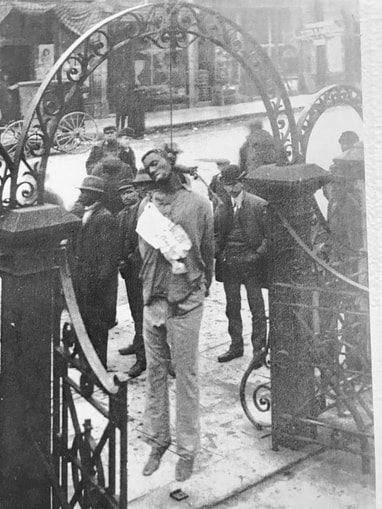 George Carter and the crowd he attracted after his hanging in February 1901. George Carter and the crowd he attracted after his hanging in February 1901. I have been haunted by the case of Ralph Jarl, the Black 16-year-old in Missouri who was shot by Andrew Lester after ringing the elderly white man’s doorbell. Jarl’s mother had asked him to pick up his two younger brothers at a nearby home, but Jarl had mistakenly approached a home on the wrong street. Everything about this situation is shocking. Lester’s behavior is reprehensible and inexcusable, no matter how broadly you interpret Missouri’s Stand Your Ground law. Jarl did nothing more threatening than ring the man’s doorbell. In my youth, someone like Lester might have yelled, “Scram, you punk!” (Well, he might have used a different epithet.) Lester also could have opted to ignore the doorbell and simply not answer the door. But Lester made the choice to shoot the teenager—twice—without exchanging any words. In the criminal complaint, Lester stated that he was “‘scared to death’ due to the male’s size.” This is the detail that caught my attention. Jarl’s family has reported that the youngster is 5’8” and weighs 140 pounds. Lester claimed Jarl was 6 feet tall. There is a considerable discrepancy here between reality and Lester’s perception. I have seen this before. In Tessa Bishop Hoggard’s book In the Courthouse’s Shadow: The Lynching of George Carter, Hoggard relays the story of my great-grandmother’s alleged assault by a Black man while crossing a covered bridge in Paris, Ky., in December 1900. The initial report in the Kentuckian-Citizen newspaper described the incident as an attempted purse snatching. In my great-grandmother’s words, her attacker “had brown skin, weight about 200 pounds, fairly well dressed….” Two months later, a suspect was pulled from his jail cell by a group of local men and lynched in front of the county courthouse. The victim of this extrajudicial justice, George Carter, had never been charged with my great-grandmother’s assault. He was being held in the jail for another offense. But rumors had led to suspicions that he was the guilty man, and the crime against my great-grandmother had also morphed in the prurient imaginations of concerned citizens. But, as you can see from the photo, George Carter clearly was not 200 pounds. In their rush to defend my great-grandmother’s honor, did the mob hang a man who had nothing to do with the incident on the bridge? Or was the description my great-grandmother gave the newspaper at the time of the attack yet another example of white victims reporting Black perpetrators as much larger and more physically threatening than they actually are? In her book, Hoggard also relays the story of another mob lynching in Paris in 1889, where the victim had again been described by the woman he allegedly attacked as “a large, burly Negro, weighing over 200 pounds.” We have no photograph of Jim Kelly to confirm his physical size, but the common language feels suspicious, like a trope that was cemented in the minds of a fearful white population. According to the Washington Post: “In multiple studies, people who were asked to judge the size of Black people tended to see Black men as bigger and stronger than they actually were, and gave Black children the attributes of adults. The result is that they are seen as more dangerous....In some studies, [Kurt Hugenberg, a professor in psychological and brain sciences at Indiana University] showed participants images of Black men and White men who are about the same height and weight. Participants often thought the Black men appeared larger...” Yes, Virginia, there is systemic racism. It permeates so many aspects of our lives and our interactions that even those of us who try valiantly to reject racist tropes inevitably fall under their sway. Racism is pernicious, it’s prevalent, and it’s dangerous. If we refuse to recognize that, we can’t even begin to chip away at the corrosion it has caused. And our fellow citizens will continue to pay the price. 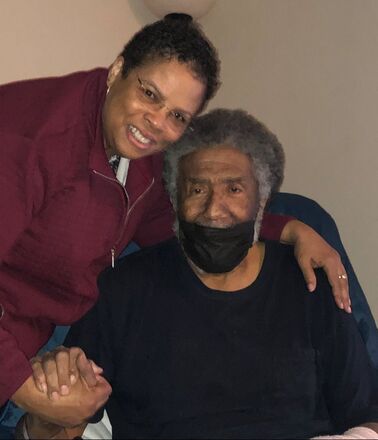 Tessa Bishop Hoggard with Jim Bannister, the great-nephew of a lynching victim, George Carter. Tessa Bishop Hoggard with Jim Bannister, the great-nephew of a lynching victim, George Carter. She spent years researching his family. She wrote and published a book examining the tragic story of his great-uncle. She arranged for him to meet a descendant of the woman who brought enormous grief upon his family. But she had never met him in person…until this week. Tessa Bishop Hoggard is on a mission. She recently traveled from her current home in Texas to her hometown of Paris, Ky., to round up support for her latest project: erecting a historical marker near the Paris courthouse where two Black men were lynched, in 1866 and 1901. The proposed marker will also honor a third man who was lynched nearby in 1889. Tessa’s purpose is clear: She wants to ensure that the citizens of her hometown—the old and the young—have the opportunity to confront the truths of its past. She is certain that only through acknowledging our dark history can we heal as a community and as a nation. So far her trip has been a success. After sending numerous emails and letters to local citizens and officials over the last year, she is finding that a brief face-to-face encounter seems to seal the deal. “I came prepared to recite the history of each of the three lynchings, to introduce these officials to the specific story of each individual,” Tessa told me. “But that hasn’t been necessary. As soon as they learn what I am proposing, they are offering support. I am truly flabbergasted. And elated.” 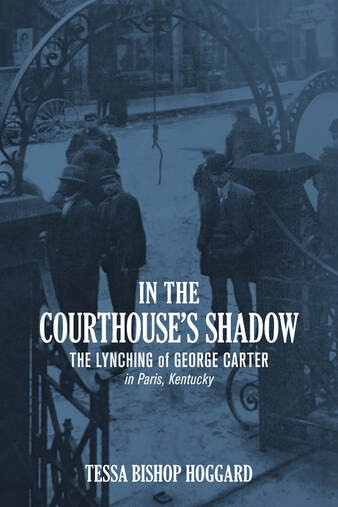 One of those victims of mob violence was Jim Bannister’s great-uncle, George Carter, who was hung on the iron gate in front of the courthouse in 1901. Carter was the older brother of Jim’s grandmother Katie—the woman who raised him. Two photos of Carter’s body hanging from the noose still exist and are reprinted in Tessa’s superb book In the Courthouse’s Shadow: The Lynching of George Carter in Paris, Kentucky. Those photos, and the newspaper description of the original incident that eventually led to mob violence, raise suspicions about whether Carter was even involved in the alleged “assault” of a local banker’s wife, Mary Lake Barnes Board, my great-grandmother. Initial reporting described the incident as an attack by “a negro man, who attempted to grab her pocket-book.” [The Kentuckian-Citizen, Paris, Ky., December 5, 1900] Many of you already know the story of how Tessa arranged from afar for me to have a public conversation with Jim Bannister in 2020. That conversation offered him an opportunity to express his grief and his frustration at not being able to uncover the truth of his great-uncle’s story, as well as his relief that it was finally being aired in public. It offered me a chance to publicly voice my regret for the horror his family endured and my apology for the role my family played in what took place. This week Tessa, Jim, and I gathered together for the first time. Emotions ran high. We took turns expressing how profoundly grateful we are for all that has transpired in the last two years. We hugged. I shed a few tears. Jim and I talk fairly often (we have to dissect Kentucky basketball on a regular basis), and I have seen him a handful of times, despite the challenges of the pandemic. But he and Tessa were in the same room for the first time. It was breathtaking to witness. In early 2023, Tessa will submit her application to the Historical Marker Program of the Kentucky Historical Society. It appears her trip this week has accomplished her goals: she has met with local officials, she has solicited letters of support, and she has revisited the scene of these tragic extrajudicial hangings. She also met George Carter’s great-nephew for the first time. 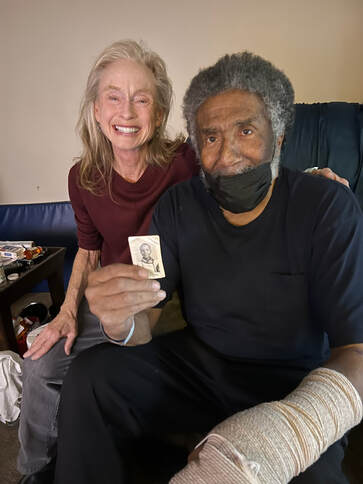 Sallie Showalter, the great-granddaughter of the woman allegedly assaulted by George Carter, with his great-nephew, Jim Bannister. Jim is holding his school photo from 1947-48, which Tessa found in her late mother’s belongings. Tessa’s interest in George Carter’s story was ignited when her mother shared a newspaper clipping she had kept from 1978 retelling the story of the hanging. 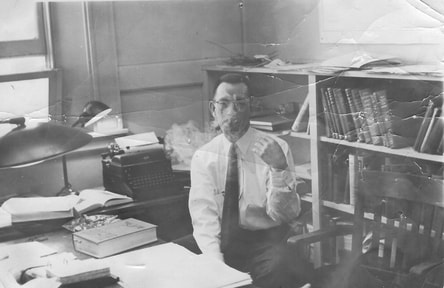 Professor John Campbell "Pud" Goodlett, my dad. Professor John Campbell "Pud" Goodlett, my dad. My father was a professor. My sister was a professor. My cousins were professors. So when J. D. Vance—possibly the most hated “man of letters” in the Commonwealth of Kentucky and Ohio’s current Republican nominee for U.S. Senate—dusted off the old Nixon trope “The professors are the enemy,” I was pert near required to take offense. Not that that was the most offensive thing that Vance has spewed during his gold star campaign of shame. That prize has to go to his declaration that women should stay in violent marriages for the sake of their children, comments he made in front of a California high school audience last year. But back to the diatribe against professors, who, I’ll just add, might also be women trying to survive abusive marriages. Vance, as most of you know, benefited from the instruction of professors at two of our nation’s most esteemed institutes of higher learning: Yale College of Law and The Ohio State University. His adopting Nixon’s old cry is disingenuous at best, dangerous and targeted at worst. Like so many of the most vocal haters and bigots on the populist right—Ted Cruz, Ron DeSantis, Josh Hawley, Donald Trump—Vance has an Ivy League pedigree. I hope his caustic comments about the teachers he studied under will prevent those who agree with him from taking up valuable space in our post-secondary classrooms. All of this pernicious rhetoric is part of a much more dastardly Republican plan to destroy public education and make empty-headed voters more susceptible to their lies and propaganda. And it’s working. Teachers are leaving their chosen profession in droves and fewer and fewer students are stepping up to fill the pipeline. States are drafting military veterans and current college students to stand in front of classrooms full of impressionable youngsters. State legislators are siphoning money away from public schools to fund charter schools that aren’t beholden to state education policies. The U.S. Supreme Court ruled that school vouchers in Maine can be used to offset tuition for religious schools. What public school teachers can say in the classroom is being prescribed by state legislators and angry school board members. Books are being banned, library shelves emptied. Our democracy is under attack. Our schools are under siege. Our nation is breaking apart. And, still, J. D. Vance, in an effort to garner votes from Ohio’s electorate, stands on stage and excoriates the very teachers who gave him the confidence to pull himself up by his own bootstraps and escape the suffocating desperation of his family. Does he not realize that Ohio, with 195 degree-granting postsecondary institutions, may well have one of the highest professors per capita among U. S. states? And that all of those professors have extended family who vote? Perhaps he sought political advice from Kentucky’s one-term governor Matt Bevin, who antagonized teachers across the commonwealth with his persistent attacks on their integrity. Bevin attended Washington and Lee University, where he became fluent in Japanese and majored in East Asian Studies, solid preparation for leading a state where Toyota and its Japanese satellite companies changed the state’s economic trajectory. Like Vance, he clearly benefited from his professors’ tutelage. Vance may well win this election, although I’ll put my money on Democrat and current U.S. Congressman Tim Ryan. Maybe if Vance had paid more attention to his professors, he could run on facts rather than be enslaved to his party’s propaganda and lies. 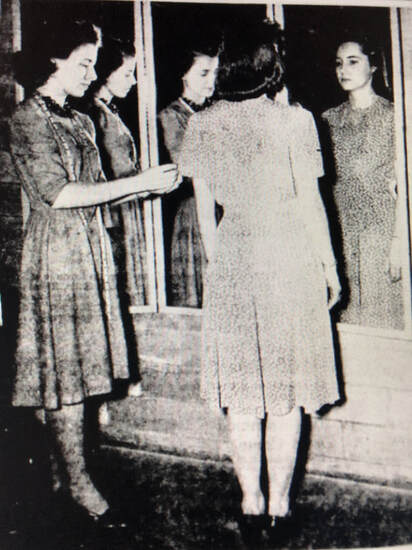 My mother, Mary Marrs Board, on the right, when she was a University of Kentucky student. In the photo, which appeared in the Lexington Leader on November 21, 1940, she is serving as a model for an award-winning “silk print afternoon dress” designed by the student on the left. My mother, Mary Marrs Board, on the right, when she was a University of Kentucky student. In the photo, which appeared in the Lexington Leader on November 21, 1940, she is serving as a model for an award-winning “silk print afternoon dress” designed by the student on the left. I’m not thinking about young girls who will grow up without the protections of Roe. I’m not thinking about the students or the young married women who have lost the choices they had yesterday about their futures and their families. I’m thinking about my mother. My mother, who entered college in 1939 without the assurances I had in 1977. My mother, who so desperately wanted children that she took prescribed poison to protect her pregnancies. My mother, who made sure I understood the choices women had before legal abortion. I can see the two of us sitting in our den in the lower level of our Lawrenceburg home, dim sunlight coming through the dirty glass of the sliding doors that opened to the broad yard. I was sitting on the stone hearth of the fireplace. She was across from me on the sofa. She told me what frantic women had done before. She was matter-of-fact. I was horrified. Incensed. And here we are again, fifty years later. I wonder how my mother would react to today’s news. Would she be as irate as I am about the cruelty of this decision? Would she be more sanguine, having seen more of life, and politics, than I have? Or would she simply be numb? Losing this one “right” may seem small potatoes compared to the looming threat of losing our democracy. How many women and families are really affected? In recent years, fewer than a million women in the U.S. made that choice—fewer than the number of Americans who have died of Covid. And we’ve mostly brushed aside that trauma. I suppose we’ll forget about this, too, in a few short weeks as we make the most of the waning days of summer. But I urge you to be vigilant as the tectonic plates shift ominously beneath us. Exercise the rights you still have. Send a clear message to our self-serving elected representatives. We are the majority. We gave them their power. That is what we can take away. 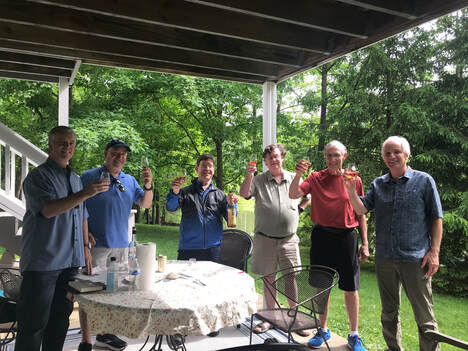 A subset of my “family” celebrating a birthday in May 2022. Photo by Joan Brandt. A subset of my “family” celebrating a birthday in May 2022. Photo by Joan Brandt. When my mother died in 1991, I looked around and realized how tiny my “family” had become. My father had died in 1967. I had no grandparents. I was married, and I had one older sister, who soon would move hundreds of miles away. I didn’t like what I saw. So, as I was putting death certificates in envelopes to send to government and insurance and financial agencies, I made a decision. I had a bunch of smart, funny, fascinating cousins. Only a few had I spent much time with; they were all older than I was, some nearly 18 years older. They had grown up at a different time and had different experiences. But I decided right then that I wanted to find a way to pull them in closer. So little by little I reached out to them. As the youngest, it felt a little awkward sending entreaties to my revered, accomplished relatives, but I tried to suppress my insecurity. I asked them to meet me for a meal in Lexington. I invited them to watch polo at the Horse Park. I made a trip out west to see my cousin in Seattle. I spent time in Indianapolis where two of my cousins were caring for their mother, whom I adored. I traveled to North Carolina and Florida to hang out with the more elusive ones, took car trips to Atlanta with the gung-ho ones. I went biking with one cousin, visited the art studio of another, hiked with a few, exchanged political emails with several. When Rick and I moved to “Camp Showalter” here on the lake, I tried to organize occasional family gatherings so we wouldn’t see each other only at funerals. For a while, I even got better at sending Christmas cards. When my friend David Hoefer urged me to compile my father’s early writings in The Last Resort, I had new and more urgent reasons to contact my cousins, especially the older ones. They knew my dad. They had stories. They had spent time with him on Salt River. I always enjoyed our conversations and their company. Then I started this blog. My initial audience was essentially relatives and a few friends. As book projects came and went and the focus of the blog shifted, my connection with my cousins deepened. Anyone who knows me now knows that when I talk about my “family,” I mean my cousins. Which is why the following passage in a recent New Yorker magazine article struck a chord with me. The author, Peter Hessler, is describing his Chinese students at Sichuan University, where he was teaching in 2019. “Among all my students that fall, nearly ninety per cent were only children. I learned that when asking [about their families] I had to clarify what I meant by the word “sibling,” because otherwise students might include cousins in their responses. As families shrank, the term broadened—for many young people, a cousin was a kind of substitute brother or sister.” I couldn’t have said it any better. So to all of you cousins—first, second, third, or fourth—thanks for letting me latch on to you and your families. You have enriched my life in immeasurable ways. I look forward to more gatherings by the lake, more chance meetups on a whim, more walks along the trails. Hail, hail, brothers and sisters! 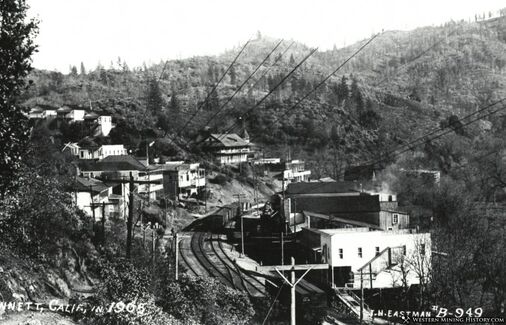 The remote community of Kennett in northern California in 1905. Some local newspapers referred to the town as “Kennet.” The remote community of Kennett in northern California in 1905. Some local newspapers referred to the town as “Kennet.” This is the third in a series of blog posts about my great-great uncle Richard T. Board, the uncle of my already infamous grandfather William Lyons Board. (Read Part I and Part II.) Many thanks again to my friend Tessa Bishop Hoggard for discovering yet another curiously dissipated ancestor of mine. It is only because of her extensive research that I am able to share these startling stories with you. As Richard Board approaches 40, perhaps he takes stock of his various schemes to find his fortune. As a young man, he evidently abandons a steady position as the deputy clerk to his father in his hometown of Harrodsburg, Ky.—or is run off for his repeated petty thefts and frauds. In 1885, when President Grover Cleveland appoints him to a federal position with the National Railway Service despite his criminal history, he steals a money order during his first trip aboard the train in New Mexico. Arriving in California sometime after serving two years in a federal prison in Illinois, he takes up with the former nurse to a soon-to-be-heiress. When no king’s ransom comes her way, he resorts to sending teenage boys into local stores to defraud proprietors. But that gets him a year in San Quentin. So what’s next? What might catch the attention of our aging antihero in California in 1899? Gold. By 1900, Richard and Mary have settled in Shasta County in northern California, near the town of Redding, with their son, approaching five years of age. The couple welcomes another baby about that time, a girl. They’re living in a cabin in the remote mining community of Kennett, where Richard is a partner in a gold mine. But it’s not long before he finds more trouble. Parties had evidently wrangled over who owned the Clipper Mine, and the courts had ruled in favor of one Alfonso di Nola over W. V. Huntington, from whom Board leased a portion of the mine. A fellow named Ross Spencer sub-leased from Board. On Monday, November 12, 1900, Spencer accompanies the newly certified owner, Alfonso di Nola, to the mine. Board appears from the mine with a gun and threatens to kill Spencer. Spencer and the three other men overpower Board and take his gun. Two days later Spencer swears out a warrant on Board for assault with a deadly weapon with intent to kill, a felony. Board is arrested the next day. Simultaneously, Board is served a second warrant for a misdemeanor: passing a fraudulent $30 check at the Golden Eagle Hotel with no funds in the Bank of California to cover it. Bonds of $500 for the felony and $50 for the misdemeanor are somehow paid—or dismissed, with the help of Board’s attorneys—and Board is released from custody. On November 19 Board pleads not guilty to the misdemeanor, and the case is eventually settled out of court. On December 13 the felony charge is referred to the Superior Court. On January 4, 1901, the same Redding newspaper that has been meticulously covering the criminal charges against Board reports in the “Town and County” section that “R. T. Board, lessee of the famous Clipper mine near Kennett, spent New Year’s in this city.” Richard T. Board Jr. has once again found his way from the police blotter to the society pages. Late that same New Year’s Day, a monstrous snowstorm descends upon northern California. One hundred miles north of Redding, the town of Yreka reported 63 inches of snow had accumulated by January 3, where “snow drifts were 6-7 feet in town, and businesses came to a halt so everyone could shovel snow off the businesses and keep their roofs from collapsing.” Rather than returning home to Kennett to check on his family as the storm settles in, Board chooses to travel on to San Francisco to meet with the owners of the Clipper mine. A week later, on Monday, January 7, Mr. Robert Hart—who had been part of the group accosted by Board in November and whose life it was rumored Board had threatened even before that incident—takes another man to Kennett to check on the Board family, “thinking the heavy snow might have caused them to be in distressed circumstances.” [The Searchlight (Redding, Calif.), January 8, 1901. All subsequent citations are to this newspaper unless otherwise noted.] They discover the Board cabin has been crushed under the weight of the snow. The tableau inside is horrific. On January 17, 1901, The Feather River Bulletin (Quincy, Calif.) runs the following headline: “Five Days the Baby Lived While Starvation and Gangrene Sapped Life.” The article included this report from the Free Press: Mrs. Board was killed by a falling of the roof. She had perhaps doubted if it would hold up under the great weight of snow. She may have been in fear for hours, and had drawn on a pair of overalls as if to be ready to flee the cabin if necessary. She had gone to the buggy where her baby lay. A key carried in her hand she thrust between her teeth that she might use both hands to lift the baby. As the mother bent over, a corner of the roof gave way and the timbers fell upon her, crushing her across the baby buggy. Her throat fell across the wicker side and she was strangled to death. The lad was not hurt by the falling roof. Tracks around the cabin showed where he had crawled out and run about, probably shouting, only to be mocked by the solitude. At last weakened by starvation he had lain down by his mother's upright dead body and exposure soon brought about his death. The child in its perambulator was shielded from the cold blasts. It could not freeze, but slowly it starved. The mother's body pressed the child's abdomen and circulation in the lower half of the body had ceased. Though the child was alive after five days, when discovered Monday, its tiny feet had turned black and gangrene was reaching upward toward the knees. The little one lived only a few hours after being released. Removing the bodies is not an easy task. “It was found necessary to make an improvised sled from one of the doors of the house and upon it the bodies were drawn to Kennet over the deep snow.” (January 8)
As word spread of the tragedy, the newspapers speculate about Richard Board’s whereabouts. His horse had been found at Kennett, probably at the train station where he had embarked first to Redding and then to San Francisco. Not being able to ascertain where he was during the storm, reporters don’t hesitate to admonish him for having abandoned his family in a time of peril. He is accused of longtime negligence. Three days later he is sighted in Redding. “Thursday evening R. T. Board passed through Redding on the northbound California express en route to Kennet, from where no one knows…Early Friday morning [he] started for the Clipper mine.” (January 11) When he arrives at Kennett, he finds his family’s coffins on the platform at the station. Arrangements had been made by Mary’s sister, Mrs. Martha Beadle Gowans, to transport the bodies for burial near her home in Sonoma County. Richard has a week to come up with a story. On Saturday, January 19, he returns to Redding to make a statement to the newspaper. He tells a convoluted tale of having asked a friend to check on his family as the snowstorm arrived and he departed for San Francisco, and of three men ordering him out of Kennett when he arrived to find his family’s remains at the train station. The newspaper immediately counters its recent accusations of negligence with a rather fantastic tale based on Board’s personal report. The next day, the headline offers this new narrative: “R. T. Board Experiences a Tragedy of Woe.” The article gushes with new-found sympathy for the bereaved widower: “But few men suffer the lot of Richard T. Board of Kennet. While far from his home and loved ones on business, the result of which meant the very means of sustaining life within them, the unfortunate man was robbed of his wife and two babies by one fell stroke.” His woes are indeed piling up. On that same Saturday, Board appears before the superior court judge on the felony assault charge. When the district attorney reduces the charge to simple assault, Board changes his plea to guilty, claiming that his actions were in response to Spencer coming to his home back in November at a time when he was away and ordering his wife and children from the house while insulting his wife with “unbecoming language.” (January 25) In lieu of a $180 fine, which Board cannot pay, the judge sends him to the county jail for 90 days. Board soon discovers more anguish for his baleful lot. As the Redding Searchlight continues its rapid reformation of its opinion of Board—who’s now sitting in the county jail—it writes the following headline on February 15: “Troubles Come in Battalions: More Sorrow for R. T. Board, to Whom the Fates Have Been Unkind Indeed.” The article relays that “After having passed through troubles more than sufficient to try the stoutest heart [Board] learned by dispatches in the coast’s papers that his sister-in-law has been made the victim of a negro fiend.” The sister-in-law referenced would be my great-grandmother, Mary Lake Board, who had allegedly been assaulted on the 2nd Street bridge in Paris, Ky., in December. That incident resulted in the lynching of George Carter in front of the Bourbon County Courthouse on February 11, 1901. In response, Board writes to the editor of the Redding Searchlight from his jail cell: “My poor old mother must be heartbroken….It is almost enough to drive me crazy, but I will overcome it and yet make my way through this world, in a way which will be a blessing in the memory of my dear ones.” Upon his release from jail in April, the San Francisco Chronicle (April 20, 1901) further embellishes on his family’s plight in an article headlined “Victim of Many Misfortunes”: “Since his incarceration his brother’s wife has been assaulted by a negro at Paris, Ky., and the negro burned at the stake.” Those of you who follow this blog know that is a false statement, yet there appear to be no bounds for newspapers at the time when invention fosters sensationalism that sells papers. Richard T. Board Jr., with his privileged upbringing, regular access to men of power, and his recognition of the authority of the press to shape a story, can construct his family’s narrative, and our nation’s recorded history, through a series of glib conversations and eloquent letters. Ultimately, what was Richard’s response to his “many misfortunes”? As seemed to be the Board family ritual, he took the next train out. The next month, May 1901, he leaves Kennett for Los Angeles to work for the Sierra Railway Co. of California, which was then engaged in a large tunnel project. Accounts seem to indicate he spent a relatively quiet year or two there, working as an assistant agent and a car cleaner, before returning to the mines in northern California, and to his life of petty crime.  Richard T. Board’s intake photo (top) and discharge photo (bottom) from San Quentin Prison. His offense is listed as “felony”—probably a clerical error since he was convicted of forgery. Richard T. Board’s intake photo (top) and discharge photo (bottom) from San Quentin Prison. His offense is listed as “felony”—probably a clerical error since he was convicted of forgery. This is the second in a series of blog posts about my great-great uncle Richard T. Board, the uncle of my already infamous grandfather William Lyons Board. (Read Part 1) Many thanks again to my friend Tessa Bishop Hoggard for discovering yet another curiously dissipated ancestor of mine. It is only because of her extensive research that I am able to share these startling stories with you. Nine years after being released from federal prison in Illinois, where he served two years for stealing a $163 money order from a mail service train on its way to Santa Fe, N.M., Richard T. Board Jr. sits next to his attorneys in another courtroom, this time in Alameda County, Calif., with a baby in his arms. It’s August 1897. During the trial, he does not deny that he endorsed a $50 check with his kindly benefactor’s name—a woman who had provided him shelter on her ranch when he was destitute—and then asked a 15-year-old boy he approached in the street to have it cashed at Kahn Brothers shoe store. But he claims that he was driven to this criminal act only by the dire circumstances of his poverty. After losing his job at Judson Iron Works, he had been struggling to find work and was searching for a way to feed his family, including his wife, there in the courtroom anxiously watching the proceedings, and the baby he continues to hold. He also makes a point to mention that he and his wife, Mary, had recently lost another child. How had Board gotten into this predicament? After being discharged from the Army in July 1894, he had remained in the San Francisco area and married Mary Hannah Beadle in December. He may have done a brief stint in the Marine Corps, serving at the Navy Yard on nearby Mare Island. It’s more certain that he joined the National Guard in April 1896 and was honorably discharged in September. Now in his mid-30s, these enlistments may well have been his best shot at a steady paycheck. The U.S. military services were evidently happy to accept a convicted felon in their ranks. But now he finds himself in yet another courtroom facing yet another term in prison. Newspapers across the country are covering this trial, just as they did his first. Board is repeatedly identified as “a protégé of ex-Senator Joe Blackburn of Kentucky [whose] father was for thirty years clerk of the United States circuit court of Kentucky.” [The Omaha Evening Bee, 04 July 1897] No newspaper mentions the younger Board’s multiple arrests for forgery or theft. None mentions his previous incarceration. Board tells them exactly what he wants them to print, which is whatever he thinks will help his case. In the end, the judge—clearly affected by the pathos of the situation before him—gives Board the minimum sentence for his offense. Board is sent to San Quentin for one year. Is it possible that the judge was not aware that Oakland police had a warrant for Board’s arrest a year earlier for similar crimes: sending boys into butcher shops and breweries to cash checks and thus defraud the proprietors? According to the San Francisco Call, a string of these crimes had again been reported in the weeks leading up to Board’s arrest in June. His forgery of the check in the shoe store was not an isolated crime committed in a moment of desperation. Nevertheless, it’s almost certain that the judge was aware of who Mary Beadle Board was. Just as it’s almost certain that Richard Board knew who Mary Beadle was long before he ever left St. Louis for his Army stint in San Francisco. Was it mere happenstance that he landed in the very city where one of the nation’s most sensational trials was taking place? Or did Richard Board arrive in California with designs on the aspiring teenage heiress Florence Blythe or her nurse, Mary Beadle? Let’s jump back a bit and pick up Mary’s story. 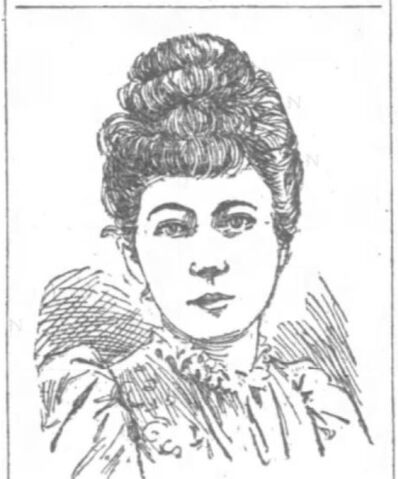 Heiress Florence Blythe Hinckley, from the San Francisco Chronicle, 01 December 1892. Heiress Florence Blythe Hinckley, from the San Francisco Chronicle, 01 December 1892. On April 4, 1883, real estate tycoon Thomas Henry Blythe died suddenly at his home in San Francisco at age 60. A native Englishman of some reserve and mystery, he had amassed a $4 million fortune and owned vast property in San Francisco, San Diego, and Mexico, as well as a mining property in Nevada. Upon his death, more than 100 women came forward claiming to be his widow or his heir. Ten-year-old Florence Blythe, whose family asserted she was Blythe’s illegitimate daughter and sole legitimate heir, was brought to California from her home in England shortly after her father’s death by her maternal grandfather, Mr. James Crisp Perry, his wife, Kate Beadle Perry, age 30, and her sister, Mary Beadle, age 24. Mrs. Kate Perry was frequently identified in the press as Miss Blythe’s “guardian” and Mary Beadle as her “nurse” or as a servant in the Perry household. Initially, no will could be found, and the courts wrestled with Blythe’s estate until the matter was sent to trial, six years after his death, on July 15, 1889. A verdict would not be reached in the complicated case until 1895. Five days after the trial began, one of the attorneys for Florence Blythe announced that he had located Mr. Blythe’s missing will in Los Angeles, where it had been stashed by Mr. Blythe’s housekeeper, who claimed after his death to be his widow. The will bequeathed the entire estate to his young daughter, Florence Blythe. The attorney also had letters written by Mr. Blythe to his daughter and his daughter’s mother, many which had contained money for her support. The almost cartoonish melodrama of the trial was breathlessly covered by newspapers across the country, including in St. Louis, where Richard Board could follow the lurid details in the Globe-Democrat after he got out of prison. He likely was familiar with all the major players, including Mary Beadle, who with her older sister and brother John were put on the stand to testify about their history with their young charge, Florence Blythe, when they all lived in England. When Richard Board lands in San Francisco for a stint in the Army in April 1892, he may have had designs on the young heiress herself. But on June 22, 1892, 19-year-old Florence Blythe surprises her loyal followers by marrying the boyish Fritz Hinckley, 23, heir to his father’s foundry business. (Fritz dies tragically five years later after suffering appendicitis while traveling with friends to Salt Lake City.) So perhaps Richard then sets his sights on Mary, who expects to receive a sizable sum ($10,000-$15,000) for her services working for the Perry family once the estate is settled. And on December 3, 1894, Richard marries her. But things don’t go as planned for the newlyweds. Florence Blythe Hinckley disapproves of the marriage (because Board had made overtures to her?) and casts Mary aside. Florence’s grandfather, James Crisp Perry, dies and his wife Kate, Mary’s sister, remarries. The Boards find themselves abandoned by Mary’s family and penniless. Before her husband’s trial begins, Mary announces she intends to sue the Blythe Hinckley estate and her sister for the money she feels she is due. A few months after Board’s trial, while Richard remains incarcerated in San Quentin, Mary’s sister Kate, now Mrs. John E. Byrne, receives $250,000 from the heiress. From all we know, Mary patiently waits for her husband’s return from San Quentin. Three months after his homecoming, Richard Board is working in the nitrate house at Judson Dynamite and Powder Works in Berkeley when there is an explosion in the adjoining mixing room. The building is destroyed and the two men who had been in the mixing room are “blown to atoms.” [Evening Sentinel, Santa Cruz, Calif., 24 October 1898] Board is thrown 60 feet but receives only lacerations. Only a wooden bulkhead had separated him from the 200 pounds of gelatin (guncotton, nitroglycerine, potassium nitrate, and other ingredients) that was being made into dynamite next door. Board described his experience to a reporter from the San Francisco Call’s Oakland office: “A little after 8 o’clock the explosion occurred, but it came so suddenly that I hardly heard anything. In fact I did not have time to think before I was in the air, with lumber and dirt flying all about me….I cannot describe the sensation…for it was most peculiar. First I seemed to be falling into a deep abyss, then the walls seemed to all cave in and I was drawn right up into space.” After yet another encounter with fickle fate, Richard T. Board Jr. walks away nearly unscathed. Soon his remarkable luck will protect him once again, while tragedy befalls all those around him. 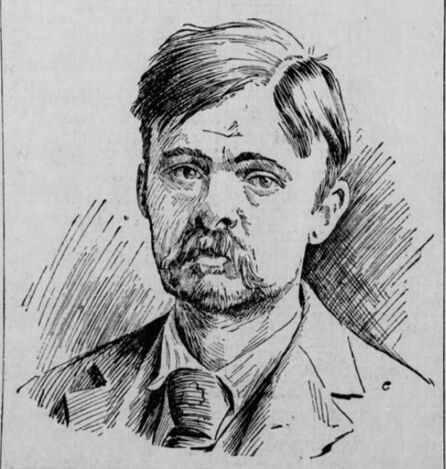 Richard T. Board Jr., from a drawing that appeared in the San Francisco Call in 1897. More on that story in Part II. Richard T. Board Jr., from a drawing that appeared in the San Francisco Call in 1897. More on that story in Part II. This is the first in a series of blog posts about my great-great uncle Richard T. Board, the uncle of my already infamous grandfather William Lyons Board. Many thanks to my friend Tessa Bishop Hoggard for discovering yet another curiously dissipated ancestor of mine. It is only because of her extensive research that I am able to share these startling stories with you. The Republicans were outraged. Couldn’t this administration appoint any officials who weren’t already corrupt or proven criminals? Grover Cleveland, the newly elected president, was the first Democrat to sit in the White House since the Civil War, and newspapers across the country railed against his inept hiring practices. The St. Albans [Vermont] Weekly Messenger repeated what was evidently a common refrain: “Another jail bird appointed to office by the democratic administration.” The article goes on to say that soon after Richard Board, age 25, was appointed clerk for the Rincon to Deming, N.M., route of the U.S. Railway Mail Service, prominent citizens in his hometown, Harrodsburg, Ky., notified the federal government that “Board was under three indictments for forgery, and had been three times arrested in Cincinnati for getting money under false pretense, once in Texas for robbery and twice for theft in Kentucky.” I have not been able to corroborate all these claims. Nonetheless, how on earth had young Richard Board gotten this plum assignment in the 15-year-old Railway Mail Service? Richard T. Board Jr. was the eldest of three sons of Richard T. Board Sr., the highly respected longtime circuit clerk in Mercer County, Ky. (county seat, Harrodsburg). The son had worked as the deputy clerk to his father for at least a couple of years. Richard Board Sr. was well known among Kentucky’s political powerbrokers. The First Comptroller of the Treasury in the Cleveland administration was Hon. Milton J. Durham, a native of Danville, Ky., one county south of Mercer. Durham had evidently sponsored Board’s appointment upon the recommendation of Kentucky’s Democratic U.S. Senator Joe Blackburn (younger brother of Kentucky Governor Luke Blackburn, whose term had ended in 1883). It probably didn’t hurt that the assistant postmaster general during the Cleveland administration was Adlai Stevenson, a Kentucky native who evidently was eager to fire Republican postal workers and replace them with Southern Democrats. This was the machine behind young Richard’s federal appointment. Somewhere along the way, no one bothered to ask about his character. Two weeks after Board was named to the post, Comptroller Durham, according to the St. Albans newspaper, “got a lively letter from a friend in Kentucky, reciting Board’s criminal record in full. The letter concludes with the prediction that Board would steal something before he had been in the service a month. The prediction was fulfilled. Before the warning note was written Board had stolen a money order for $163.” Board had been appointed to the position on July 7, 1885, dismissed on July 30, and, on August 17, was arrested in St. Louis where he previously had been living with his wife of eight months, Fannie Mace. The St. Louis Globe-Democrat claimed he had illegally used his Railway Mail Service transportation card to travel back to Missouri after his dismissal. Board was unable to pay the $1,500 bail and was remanded to jail in St. Louis. After being transferred to a Santa Fe jail, he stood trial in Socorro, N.M., in March 1886 and was found guilty of robbing a registered letter from a train heading to Santa Fe. Never one to blame himself for his misfortunes, Board evidently claimed, and The Sierra County Advocate of Kingston, N.M., reported, that “His downfall [was] attributed to an immoral female.” After the trial, federal marshals brought Board back to St. Louis and he was delivered to Southern Illinois Penitentiary at Chester (now Menard Correctional Center), 60 miles southeast of St. Louis, to serve a two-and-a-half-year term. On February 7, 1888, while his oldest son was still in prison, Richard T. Board Sr. died of a paralytic stroke at age 62. According to the Stanford, Ky., Interior Journal, he had been “on the street apparently well an hour before.” Newspaper documentation shows that Richard T. Board Jr. had indeed been arrested multiple times for forgery and theft before he was incarcerated in Illinois. Reports indicated that his father had done all he could to honor his son’s debts and rescue him from his scrapes with the law. In September 1883, records show Richard Board Jr. had been arrested in Cincinnati for forging his father's name to a check at the National Saloon. According to the Cincinnati Enquirer, “In his pocket was found a touching letter from his brother in Harrodsburg, Ky., begging him for the sake of his folks to behave himself.” That brother would be my great-grandfather, William Ellery Board, father of William Lyons Board. A few months later, in January 1884—while working as a bookkeeper in St. Louis, a few months before marrying Fannie—Board passed a false $10 check written on a Harrodsburg bank to the Pacific Express Company. In lieu of an $800 bond, he went to jail. I can only assume that Richard Board Jr. returned to his wife in St. Louis after he was released from prison on May 4, 1888. By June 1892, however, Fannie had filed for a divorce from Richard Board, accusing him of “brutality and general indignities,” according to the St. Louis Globe-Democrat. By then, Board was already gone. On April 30, 1892, at 31 years old, he had enlisted as a private in the Army and was stationed at the Presidio in San Francisco. Richard Board Jr. had landed in the wild west, and he would spend the next 25 years wreaking havoc up and down the coast, leaving tragedy in his wake. 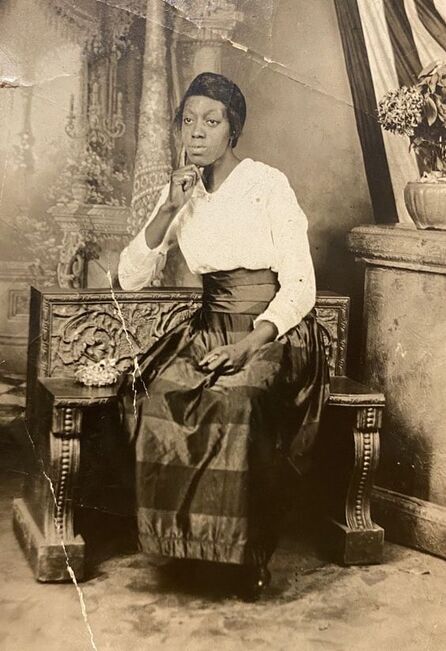 Katie Carter, the younger sister of George Carter and the grandmother of Jim Bannister. George Carter was lynched in Paris, Ky., in 1901. Photo provided by Jim's daughter, Cheryl. Katie Carter, the younger sister of George Carter and the grandmother of Jim Bannister. George Carter was lynched in Paris, Ky., in 1901. Photo provided by Jim's daughter, Cheryl. On February 23, 1900, Rep. George Henry White (R-N.C.), the sole Black U.S. lawmaker at the time, gave an impassioned speech on the House floor about the antilynching legislation he was proposing. The bill would make mob violence that resulted in the victim’s death a federal crime of treason to be tried in U.S. courts. White had felt compelled to act after witnessing the bloody Wilmington, N.C., race riot a little over a year before, during which a mob of white locals toppled the city’s multiracial government and ruthlessly murdered an estimated 60 innocent Black citizens. After White’s speech, his fellow congressmen applauded his words but failed to pass the bill out of committee. Thirty-five years after the Civil War, Southern devotion to states’ rights was still paramount. White called out some of his colleagues who had spoken against heinous lynchings in their own communities. In White’s view, these legislators would not countenance federal legislation because “this would not have accomplished the purpose of riveting public sentiment upon every colored man of the South as a rapist from whose brutal assaults every white woman must be protected.” [Washington Post, February 21, 2020] A year later, on February 11, 1901, a determined mob of local townsmen hung George Carter in front of the Bourbon County Courthouse in Paris, Ky. His crime? According to news reports: an attempted purse snatching. According to rumor and innuendo: rape. 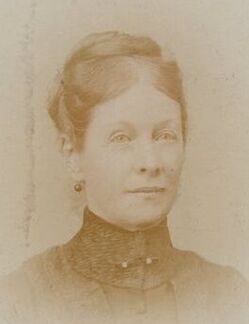 My great-grandmother, Mary Lake Barnes Board. My great-grandmother, Mary Lake Barnes Board. The woman George Carter allegedly accosted was my great-grandmother, Mary Lake Board. The eight-year-old boy who identified Carter as his mother’s assailant was my maternal grandfather, William Lyons Board. There are reasons to question whether George Carter was indeed the man who assaulted my great-grandmother. There was no trial, no presentation of evidence. There was almost certainly no capital crime. In her book In the Courthouse’s Shadow: The Lynching of George Carter in Paris, Kentucky, Paris native Tessa Bishop Hoggard scrutinizes the contemporaneous documentation and then offers a riveting account of the lead-up to the encounter with my great-grandmother and its chilling aftermath. The hanging also plays a pivotal role in the novel I wrote about my grandfather, Next Train Out. Of course, no one in that Paris, Ky., mob was ever identified or arrested. No one was charged or convicted of murdering George Carter. There was no federal hate crime or antilynching law on the books, because Congress had failed to act the year before. It was not until 1920 that “Kentucky became the first southern state to pass an antilynching law.” [John D. Wright Jr., “Lexington’s Suppression of the 1920 Will Lockett Lynch Mob,” The Register of the Kentucky Historical Society 84, no. 3 (1986): 263-79.] This month, 122 years later, after 200 failed attempts, Congress finally succeeded in passing the Emmett Till Antilynching Act, named in honor of the 14-year-old boy who was lynched in Mississippi in 1955. After President Biden signs the bill into law, a lynching resulting in death or serious bodily injury can be prosecuted as a federal hate crime punishable by up to 30 years in prison. It’s too late for George Carter, of course, or for the estimated 2,000 people who were lynched in this country after White’s original bill failed. But perhaps it’s a sign that our nation’s citizens are finally ready to take some initial steps toward ensuring justice prevails when racial hate crimes are committed. Just last month a Georgia jury found the three white men involved in Ahmaud Arbery’s murder guilty of federal hate crimes. The next day the three Minneapolis police officers who remained inert as Derek Chauvin slowly killed George Floyd were all found guilty of violating Floyd’s civil rights. It may feel like way too little way too late, but perhaps we can sense a slight rebalancing of the scales of justice. Perhaps we are moving at a snail’s pace toward that more perfect union where all men and women truly are created equal. Despite current efforts in statehouses across the country to restrict discussions of our nation’s documented history relating to racial injustice and oppression, perhaps these concrete actions are signs of movement in the opposite direction, toward transparency and a more honest reckoning of our past. We all need to feel uncomfortable about the atrocities that have been committed in this nation to buttress unequal power structures. We need to feel shame. And then we need to take action to address the lingering institutions and sentiments that perpetuate these injustices. Rep. Bobby Rush, D-Ill, the longtime champion of the Emmett Till Antilynching Act, said after the bill passed: “Lynching is a longstanding and uniquely American weapon of racial terror that has for decades been used to maintain the white hierarchy…. [This bill] sends a clear and emphatic message that our nation will no longer ignore this shameful chapter of our history and that the full force of the U.S. federal government will always be brought to bear against those who commit this heinous act.” [NPR, March 7, 2022] Bill signedOn Tuesday, March 29, 2022, President Biden signed into law the Emmett Till Antilynching Act. Till’s cousin, Rev. Wheeler Parker Jr., the last living witness to his abduction, said in response, “Laws make you behave better, but they cannot legislate the heart.” Let’s hope the hearts of all Americans are slowly recognizing the injustices that have stained our nation since its inception. eventOn Saturday, March 26, 2022, Tessa Bishop Hoggard and I participated in a Zoom virtual conversation hosted by the Paris, Ky., Hopewell Museum. We discussed the 1901 lynching of George Carter and how that dark episode prompted both of us to write our books. Connecting with Tessa ultimately led to my friendship with George Carter’s great-nephew, Jim Bannister. |
Details
Archives
June 2023
Categories
All
|


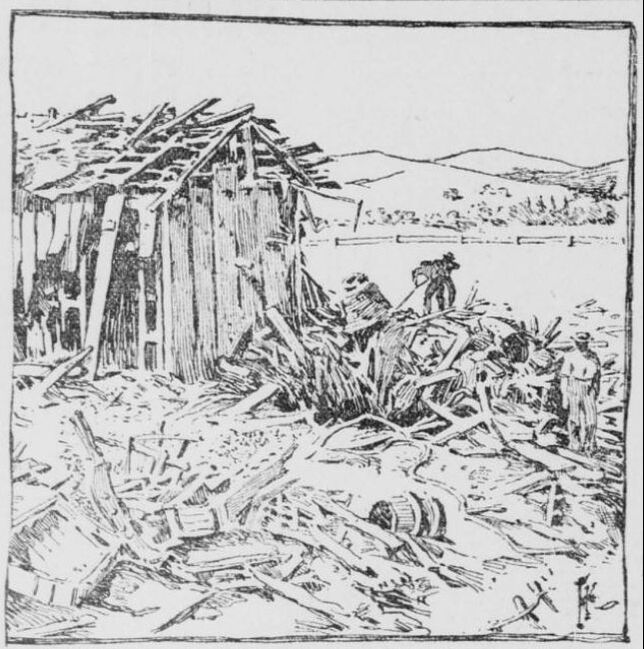
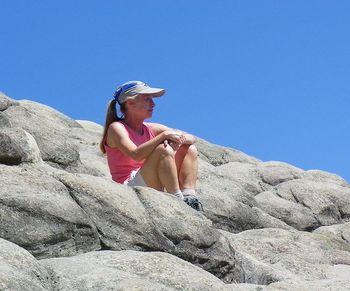
 RSS Feed
RSS Feed